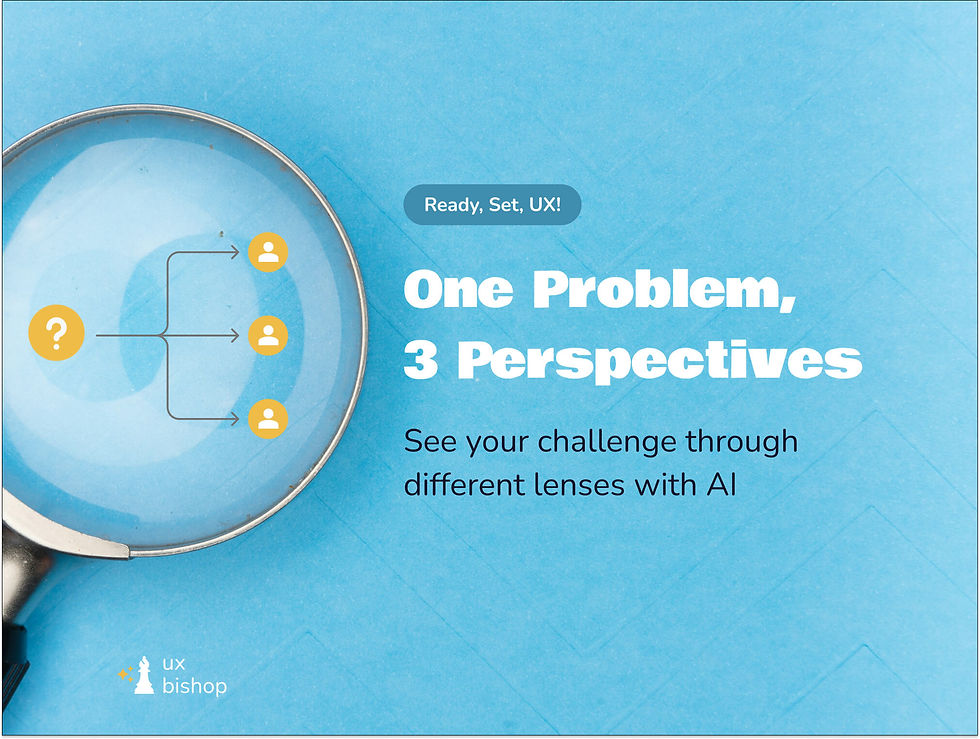One Problem, Three Perspectives: See Your Challenge Through Different Lenses with AI
- architette

- Sep 24
- 2 min read
Updated: Oct 13

TLDR Summary
Let's Reframe Problem Statements with AI. Instead of relying on a single perspective, you’ll learn how to use AI to quickly rewrite it through three lenses: user-first, tech-first, and business-first.
Why it matters:
Clarifies alignment across disciplines
Surfaces blind spots early
Ensures stakeholders see their priorities in the narrative
By the end, you’ll have a repeatable workflow for using AI to strengthen kickoff rituals and set your week up for clarity and collaboration.
What You’ll Learn in This Post
By the end, you’ll know how to:
Write a baseline problem statement
Use AI prompts to reframe it through user, tech, and business perspectives
Apply these reframes to clarify alignment in kickoff decks
Build a ritual that creates repeatable clarity for your team

Step 1: Define the Problem
Write your current problem statement in plain language... simple, direct, and without jargon. This baseline gives AI something concrete to reframe.

Step 2: Reframe Through the User’s Lens
Ask AI to rewrite the problem statement from the end-user’s perspective. This forces the statement to highlight human frustration and emotional stakes.
Example prompt:
Rewrite this problem from the end-user's perspective, emphasizing pain points and needs.

Step 3: Reframe Through the Tech Lens
Next, ask AI to reframe the problem statement from a technical perspective. This reveals what might block implementation or stretch engineering resources.
Prompt example:
Reframe this problem around technical limitations, system dependencies, or workflow challenges.

Step 4: Reframe Through the Business Lens
Finally, prompt AI to reframe the problem from a business perspective. This version aligns directly with leadership priorities and makes it easier to defend design decisions with measurable impact.
Prompt example:
Reframe this problem through business goals, KPIs, and risk considerations.

The Result: One Problem, Three Angles
With just a few AI prompts, you now have three distinct framings of the same challenge... each tailored to a different audience. Instead of presenting a one-dimensional statement, you can show stakeholders how the problem impacts users, technology, and the business.

Why This Works in Enterprise UX
Reframing problem statements with AI creates clarity fast. It:
✔ Clarifies alignment across disciplines
✔ Surfaces blind spots before they derail progress
✔ Ensures every stakeholder sees themselves in the problem

Make It a Habit
This isn’t about shortcuts... it’s about building sustainable rituals. If every kickoff starts with a reframed problem, you’ll begin the week with better clarity, stronger collaboration, and fewer surprises downstream.

Final Thought
AI doesn’t replace critical thinking... it accelerates it. By reframing problem statements through different lenses, you set the tone for design conversations that are richer, more aligned, and ultimately more effective.

Disclaimer: The thoughts shared in this blog are solely my own and do not represent the perspectives of my professional relationships or clientele.
Comments